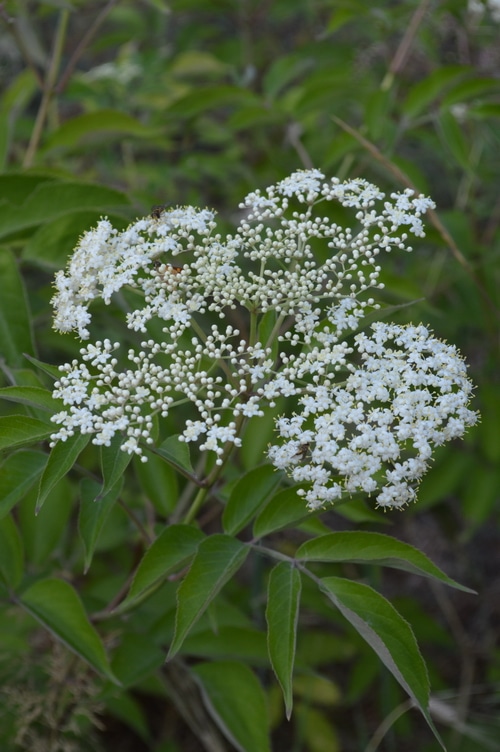Elderberry bushes are a great addition to your garden and yard. There are many beautiful varieties to chose from, and all black fruited and blue fruited elderberries can be processed for food or medicine. Both flowers and berries can be safely used if proper processing is followed.
In 2013 I purchased 9 elderberry plants from Richter’s Herbs in Ontario. Elderberry was the 2013 Herb of the Year and Richter’s had a full complement of Elder varieties to choose from. The plants were easy to establish here in zone 3, at the edge of Elder’s hardiness zone. I suspected it would grow well for me since we have the wild black elder’s on our property already. The plants have been a boon to wild pollinators, flowering all season long from May right into September, with berries ripening even as new flowers continue to bloom. If you don’t already have elders growing nearby consider this plant that was once considered an apothecary all by itself.
There are three, currently circulating, myths about the safety and efficiency of using elderberry for food and medicine. Check out the explanation behind these myths, and the safety protocols for working with elderberry. Elderberry is one of my favorite garden bushes, and absolute favorite herbal berry.
About elderberry or elder plants
Black and Blue elderberries (Sambucus canadensis, Sambucus nigra, or Sambucus glauca) grow wild throughout most of the USA and in the southern part of Canada. They are hardy from zone 2 to 11 and prefer moist soil in open areas. In freshly logged areas and beside stream banks, you’ll find elder growing and colonizing on their own. Elder can be grown from seed and in places where an elder is already established baby elder bushes spring up anywhere that birds spread the seed.
The plant is very adaptable and very hardy. Although it has a reputation for being hard to establish in a garden, new varieties are being developed to make commercial cultivation successful. Both blossoms and berries are used for both food and medicine.
The 2013 Herb of the Year honoured the Elder. If you haven’t tried elder as an herbal medicine yet, now is the time to become familiar with this generous plant. The flowers, berries, and leaves of the Elder are used in herbal medicine. In the past, the bark and leaves were used internally because they are a powerful emetic and purge, but today we look for gentler paths to restoration and health.
The DIY Herbal Fellowship:
Inside the DIY Herbal Fellowship we studied Elder as our herbal ally in October 2020. The elder has a fascinating history of herbal and mythological use:
Elder was considered to be an apothecary at your back door. The presence of an elder-bush at the front door was believed to keep harm away from the household. The flowers were used in teas, the berries in fermented preparations, and the bark and leaves were used as powerful purgatives. Due to the nature of elderberry, it is no longer recommended to use the bark and leaves in this traditional way, except under the supervision of a clinical herbalist.
There is a lot of superstition around the elder tree with taboos against cutting the wood or cutting down the tree, most likely because of the medicinal benefits that a community was able to obtain from the fruit and flowers. — Excerpted from The DIY Herbal Fellowship Herb of the Month: Elder.
Elderflowers
The flowers emerge in May or June, depending on elevation and climate. Harvest no more than 1/5th of the flowers on any bush, leaving enough to mature for berries in September. Elderflowers can be macerated in alcohol or cider vinegar to make a tincture. They can also be dried with gentle heat so that they can be used to make a tisane or herbal tea later in the season. The fresh flowers can be infused in olive oil for skincare.
Recipes using Elderflower to heal and improve the complexion
Elderflower Anti-aging Cream for Older Complexions
Elderflower Anti-aging Eye Serum
How to use the leaves
The leaves are used externally only, as they act as a powerful purge and can be toxic if taken internally. Infuse coconut oil with the leaves by heating the coconut oil until the leaves are crisp. Strain it and use it for skin eruptions, bruises, cuts, and scrapes. Add arnica, St. John’s wort flowers, and calendula blossoms to the oil with the elder leaves to make a first aid salve for cuts, bites, and scrapes. Note that this should be used externally only.
Elderberries
The berries are where the elderberry really shines. Only the blue or blackberries are used as the red berries can contain high amounts of cyanide and are potentially toxic. The elderberry has a unique tart taste for distinctive jams, jellies, and syrups. But it’s a real star when it comes to aiding in the treatment of the common cold, or the flu. The berries make excellent homemade wine, mead, and winter cordial, a dose taken just before going to bed, is an old-fashioned and well established cure for a cold.

Studies have shown that it is effective in deactivating the protein that the flu virus needs to attach itself to cells, shortening the duration of symptoms and boosting the immune system.
The dark purple colour of the berries shows that it is high in free radical scavenging anthocyanins and it is therefore being studied as an adjunct therapy for the treatment of cancer. It is similar in this regard to blackberries and blueberries, purple cabbage, purple potatoes, purple carrots, and black rice. It has more than 5 times the anthocyanins than blueberries and more than twice the anthocyanins of bilberries. Truly, “elder” berries aid us to slow down the aging process.
Bruised Elder leaves have an unpleasant odor that deters certain insects; therefore, gardeners use a leaf decoction of elder to protect other plants. — Maude Grieves
A standardized commercial preparation of elderberry syrup is available and most of the current scientific studies used this product in their double blind experiments.
Make elderberry syrup
However, you can easily make Elderberry syrup at home. Simply take your elderberry harvest and heat the berries with water. Boil fresh berries in water for 3 to 5 min. Press the juice out of the berries. Sweeten with 1 part honey to 10 parts juice. Heat to boiling. Bottle in glass and cap tightly. Keep the syrup in the refrigerator. The berries can also be dried or frozen and fresh syrup can be made as needed. Dried berries can be purchased if you can’t find them growing near you. Or make this shelf stable elderberry syrup.

An easy way to get kids to take elderberries when they have a cold or flu is to make elderberry jelly shots or elderberry gummy bears. Both are excellent vehicles for the herbal goodness of elder.
Get to know elder and your other herbal allies by studying one herb at a time
.










Please tell me how and when to prune the bush.
Take out the 3 year old canes or older, at the ground level. Any broken or dead canes can be removed as well. This should be done in winter while the plants are dormant.
Great info! I didn’t know a lot about elderberry before, but I believe it grows by a stream at my mother in law’s house. I’ll have to go foraging 🙂
We also have it growing near a creek. It has amazing medicinal properties.
I enjoyed this. Elderberry sounds like something I need to add to our gardens. thanks for the beautiful printout too.
I’m glad you enjoyed it, Janet. Thanks for stopping by.
Funny, I just finished writing about my grandfather and mentioned the first time he had me taste elderberry juice. It is everywhere around here.
I hope it was sweetened juice. Elderberries around here are pretty tart.